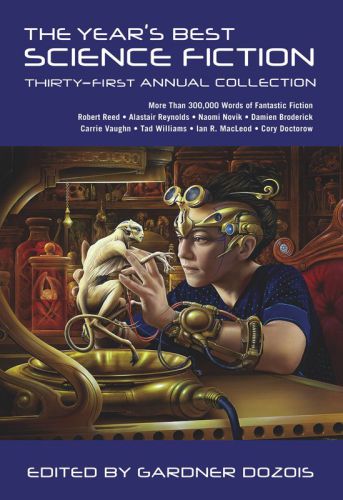
The Year's Best Science Fiction
31st Annual Collection
کتاب های مرتبط
- اطلاعات
- نقد و بررسی
- دیدگاه کاربران
نقد و بررسی

Starred review from July 3, 1995
Dozois's Year's Best, like any successful representative of a large constituency, sometimes suffers from blandness and inconsistency. As usual, it's oversized--23 stories, nearly 600 pages--and includes a variety of types of SF as well as near-horror, fantasy and humor. Five of the stories are final nominees for Nebulas, and two new ``Hainish'' stories by Ursula LeGuin were nominated for Tiptree Awards; ``The Matter of Segrri'' won. No story here is less than competent and professional; but, with a few exceptions, there is a voiceless sameness in the writing, practically a house style, that over so many pages grows tedious. (Nearly half the stories, by page count, come from the Dozois-edited Asimov's Science Fiction.) A number are flawed (``hard'' SF stories about ``aliens'' that think just like humans) or unremarkable, but these are outweighed by many fine pieces and by standouts such as LeGuin's ``Forgiveness Day,'' perhaps the best story in the book; Eliot Fintushel's ``New Wave''-like ``Ylem''; William Sanders's ``Going After Old Man Alabama'' and Terry Bisson's ``The Hole in the Hole,'' both of which are winning and funny; Katherine Kerr's chilling ``Asylum''; and Michael Bishop's grand and humane ``Cri de Coeur.'' Dozois's intelligently and ably put-together anthology does its stated job as well as any one book or editor could. Even with competition, it would still be the best of the Best.

July 1, 2014
The Dozois annual is as hefty, excellent, and nearly indispensable as ever. How not, when it contains stories by Stephen Baxter, James Patrick Kelly, Nancy Kress, Ian R. MacLeod, Robert Reed, Geoff Ryman, Melissa Scott, Allen Steele, Michael Swanwick, Carrie Vaughan, and a score of others perhaps less well known but not less gifted? Short stories are the bulk of this volume (and clearly Dozois' main interest), but the coverage in the Year in Review section includes novels, alternative print media, e-media, and visual media. The last indicates that sf/fantasy/horror have gone in one lifetime from being a fringe element on the cinematic scene to being among its most popular (and profitable) categories. Some of this is due to modern special-effects technology, and there are still clunkers on the screen, but the dark days of The Brain Eaters and its ilk are past. So, alas, are many seminal figures in the sf community, a list headed by Frederik Pohl and Jack Vance.(Reprinted with permission of Booklist, copyright 2014, American Library Association.)

























دیدگاه کاربران